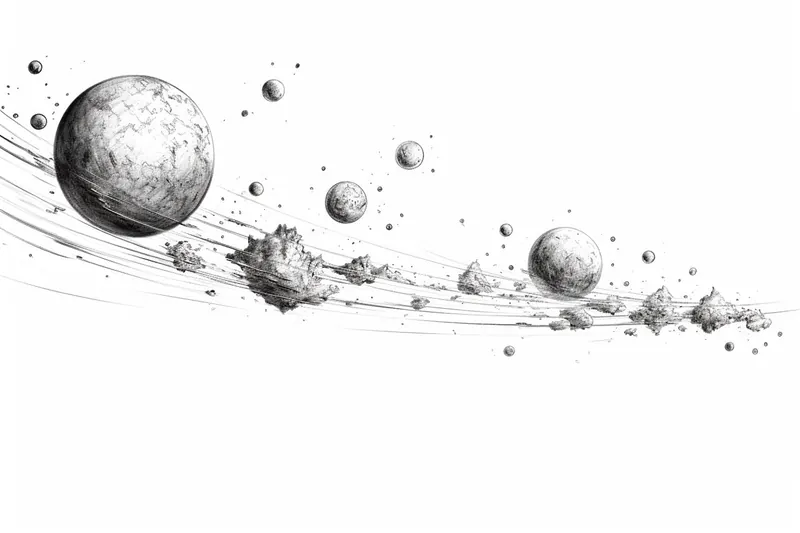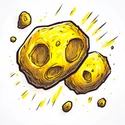How to Draw an Asteroid Belt
Learn how to draw an Asteroid Belt with expert tips and techniques in this detailed step-by-step guide. Perfect for budding artists and space enthusiasts alike.

Materials You'll Need
- Pencil
- Paper
- Eraser
 Drawing the Asteroid Belt is not just a simple artistic endeavor; it is an invitation to explore the mysteries of our solar system while engaging your creativity. This captivating subject is a blend of science and art, offering a unique opportunity for artists at any skill level to delve into the vastness of space. The Asteroid Belt, teeming with scattered rocky bodies, presents a dynamic canvas that challenges both beginners and experienced artists alike to capture its intricate details.
Drawing the Asteroid Belt is not just a simple artistic endeavor; it is an invitation to explore the mysteries of our solar system while engaging your creativity. This captivating subject is a blend of science and art, offering a unique opportunity for artists at any skill level to delve into the vastness of space. The Asteroid Belt, teeming with scattered rocky bodies, presents a dynamic canvas that challenges both beginners and experienced artists alike to capture its intricate details.
Embarking on this artistic journey entails understanding the beauty and complexity of the celestial terrain. Each asteroid, with its varied shapes and surfaces, tells a story of cosmic history, waiting to be transcribed onto paper. You'll need a keen eye for the subtleties of shading and form, which are essential to rendering the realism and depth of this awe-inspiring expanse. As you embark on this creative voyage, this guide will provide you with valuable techniques and tips to help you create a stunning representation of the Asteroid Belt.
So, gather your materials, unleash your imagination, and get ready to translate the wonders of outer space onto the page. Let's dive into the mesmerizing world of drawing an Asteroid Belt and discover how you can turn celestial inspiration into a beautiful work of art.
Materials Required
To draw an asteroid belt, you will need the following materials:
- Drawing paper or sketchbook
- Pencils (preferably various grades for shading and details)
- Eraser
- Ruler (optional for creating straight lines)
- Reference images of asteroid belts for inspiration
Optional materials that can enhance your drawing:
- Colored pencils or markers for adding color to your asteroid belt
- Blending tools such as blending stumps or tortillons for smudging and blending pencil marks
- White gel pen or white colored pencil for adding highlights and details
These materials should provide you with everything you need to create a visually appealing asteroid belt drawing.:
How to Draw an Asteroid Belt: a Step-by-step Guide
Step 1: Gather Your Materials
Gather all the necessary materials needed for drawing an asteroid belt. You will need a pencil, eraser, drawing paper, ruler, and a set of colored pencils or markers if you wish to add color to your drawing.
Step 2: Sketch the Background
Start by lightly sketching the background of your drawing. Use your pencil to draw a rough outline of the area where the asteroid belt will be located. You can make the background space-themed by adding stars, galaxies, and other celestial elements.
Step 3: Draw the Asteroids
Begin drawing the asteroids within the designated area. Asteroids come in various shapes and sizes, so feel free to get creative with their forms. Draw irregular shapes and sizes of asteroids scattered throughout the space. You can vary the shapes by drawing some elongated, others circular, and some with jagged edges.
Step 4: Add Texture and Details
To make the asteroids look more realistic, add texture and details to them. Use your pencil to create shading and highlights on the asteroids to give them depth. You can also add craters, lines, and other surface details to make each asteroid unique.
Step 5: Color the Asteroids (Optional)
If you want to add color to your drawing, use colored pencils or markers to color in the asteroids. Choose a color palette that complements the space theme, such as shades of gray, brown, and beige for the asteroids. You can also add hints of metallic colors like silver or gold to enhance the visual appeal.
Step 6: Final Touches
Once you have finished coloring the asteroids, go over your drawing to make any necessary touch-ups. Erase any stray lines or smudges, and refine the details to make the asteroid belt look polished and cohesive. Consider adding a subtle background gradient to create a sense of depth in the space scene.
Step 7: Sign and Display Your Artwork
Finally, sign your artwork in the corner to mark it as your creation. You can then display your finished asteroid belt drawing in a frame or share it with others to showcase your artistic talent.
Tip: To effectively capture the texture and variety of asteroids in your drawing, start by using a range of pencil grades – from 2H for fine details to 6B for deeper shadows. Begin with light sketches to outline the general shapes of the asteroids, varying their sizes and angles to create a sense of depth and randomness; no two asteroids are alike. Once your outlines are set, use a blending stump or your finger to softly smudge the edges, giving them a more organic, weathered appearance. Pay close attention to light and shadow; imagine a light source from a distant sun and shade accordingly, enhancing the three-dimensional feel of each rock. Finally, adding speckles of white or gray can simulate the reflective surfaces of certain asteroids, bringing your drawing to life!
Conclusion
Fantastic job on drawing the asteroid belt! Your attention to detail and use of shading really brings this celestial scene to life. Remember, practice makes perfect, so keep honing your skills and exploring your creativity. You have a natural talent for capturing the beauty of the cosmos, and I can't wait to see what other celestial wonders you bring to life through your art. Keep up the excellent work, and never stop creating!
Fun Facts About Asteroid Belts
- The largest and most well-known asteroid belt in our solar system is the asteroid belt located between Mars and Jupiter. It is estimated to contain millions of asteroids, ranging in size from small pebbles to hundreds of kilometers in diameter.
- Despite popular depictions in science fiction movies, the asteroids in the asteroid belt are actually spread out over vast distances and are not densely packed together. This means that a spacecraft could travel through the asteroid belt without encountering any obstacles.
- Ceres, the largest object in the asteroid belt, is classified as a dwarf planet. It is approximately 590 miles (940 kilometers) in diameter and is composed of rock and ice.
- The asteroid belt is thought to be the remnants of a failed planet that was never able to form due to the gravitational influence of Jupiter. Instead of coalescing into a single planet, the material in the region between Mars and Jupiter remained as numerous small bodies.
- Asteroids in the asteroid belt are made up of a variety of materials, including rock, metal, and sometimes even organic compounds. Some asteroids have been found to contain valuable resources such as rare metals and water ice, making them potential targets for future space mining missions.
- The first asteroid ever discovered, Ceres, was found by Italian astronomer Giuseppe Piazzi in 1801. Initially classified as a planet, Ceres was later reclassified as an asteroid as more similar objects were discovered in the same region.
- The Dawn spacecraft, launched by NASA in 2007, visited two objects in the asteroid belt – Vesta and Ceres. The mission provided valuable insights into the composition and structure of these two large asteroids.
- Collisions between asteroids in the asteroid belt are relatively rare due to the vast distances between objects. However, such collisions can occur and have been observed by astronomers using telescopes and spacecraft.
- Some scientists believe that asteroids in the asteroid belt could potentially pose a threat to Earth if their
Suggestions for Scenes and Settings for Asteroid Belt Drawings
- A close-up view of two asteroids colliding in the asteroid belt, capturing the moment of impact and the resulting debris.
- A spacecraft navigating through a dense field of asteroids in the belt, highlighting the dangers and challenges of space travel in this region.
- A mining outpost established on a large asteroid, with miners extracting valuable resources and machinery scattered across the rocky surface.
- A space station stationed near the edge of the asteroid belt, acting as a hub for interstellar travelers passing through the region.
- A group of explorers conducting research on a mysterious asteroid, with scientific equipment set up and alien-like rock formations in the background.
- An asteroid mining operation in full swing, with large industrial machines extracting minerals and loading them onto spacecraft for transport.
- A peaceful scene of a lone asteroid drifting through the belt, with distant stars twinkling in the background and a sense of solitude and vastness.
- A futuristic city built on a massive asteroid, with towering skyscrapers, bustling streets, and flying vehicles zipping between buildings.
- A battle scene between rival factions in the asteroid belt, with lasers firing, explosions lighting up the darkness, and debris flying everywhere.
- A serene view of the asteroid belt from a distance, with the Sun casting a warm glow on the rocky terrain and creating dramatic shadows.